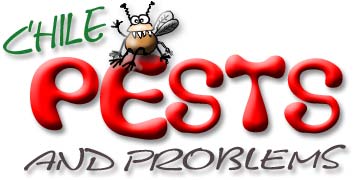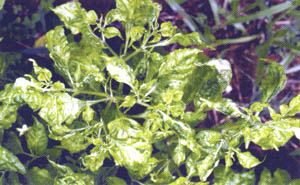By Dave DeWitt and Paul W. Bosland
Fiery Foods & BBQ Central Recommendations
Chile Pepper Bedding Plants… over 500 varieties from Cross Country Nurseries, shipping April to early June. Fresh pods ship September and early October. Go here
Chile Pepper Seeds… from all over the world from the Chile Pepper Institute. Go here
Viruses are extremely small and can only be seen with an electron microscope. Viruses alter the metabolism of plant cells, causing the plants to grow abnormally. This condition causes both decreased yields and visible symptoms, such as distorted leaves, abnormally colored leaves, dead tissue, mottled or mosaic leaves or fruit, stunted plants, or curled leaves. One plant can be attacked by many viruses and may express many different symptoms. Viruses are transmitted from plant to plant by insects, or by the grower handling infected plants.
Avoid using tobacco in any form to help protect plants against tobacco mosaic virus. Gardeners who use tobacco should wash their hands with soap and water, rubbing alcohol, or milk before handling healthy plants. Early detection and removal of infected plants helps, but complete control is often difficult.
Mosaic viruses have intermixing of light and dark green areas. The mottled areas have irregular outlines, and may follow the main veins. Infected leaves are generally smaller than healthy leaves, and are often slightly puckered and have curled edges. In severe cases, the leaves may become long, narrow, and twisted. Infected plants are usually more dwarfed and bushy than healthy plants and have reduced yields. Separating symptoms caused by mosaic diseases from those caused by abnormal pH, herbicide injury, nutritional deficiencies, feeding damage by mites or insects, and so forth may be difficult. No viricides exist that control plant viruses. To help reduce mosaic virus, use these cultural methods: plant virus-free seed, remove weeds, control insects, remove plants showing virus symptoms, and plant resistant varieties.
Alfalfa Mosaic Virus (AMV)
Symptoms: Plants are mildly stunted and have whitish blotches on the leaves. The infected area is white-bleached and mottled. The fruit may be distorted.
Control: Aphids carry AMV. Peppers planted near alfalfa have a higher incidence of the disease. Control aphids and avoid planting near alfalfa. Use resistant varieties if they are available.
Beet Curly Top Virus (BCTV)
Symptoms: The most striking symptom is stunted plants and yellowing of the plants. The plants are also quite stiff and erect, and the leaves have a leathery feel.
Control: Curly top is carried by leafhoppers. Help prevent losses by partially shading plants with muslin tents or by other means early in the season. Leafhoppers that carry the virus do not feed in shady locations. Spraying or dusting with insecticide can be justified only when control is needed for other insects.
Cucumber Mosaic Virus (CMV)
Symptoms: Aphids carry CMV and cause stunted plants with dull green foliage with a leathery appearance.
Control: Control aphids and avoid planting near cucurbits.
Pepper Mottle Virus (PeMV)
Symptoms: Stunted plants, distorted fruit, and yield reduction are symptoms.
Control: Aphids carry PeMV. Control aphid vectors, practice good sanitation, and plant resistant varieties if available.
Potato Y (PVY)
Symptoms: Symptoms include mosaic and dark green vein-banding, leaf crinkle, leaf distortion, and plant stunting.
Control: PVY is carried by aphids. This has been called the most common pepper virus. Plant resistant varieties and control aphids.
Tobacco Etch Virus (TEV)
Symptoms: Mosaic and dark green vein-banding, leaf distortion, and plant stunting are symptoms. Tabasco plants wilt and die.
Control: Aphids carry TEV. Plant resistant varieties and control aphids.
Samsun Latent Tobacco Mosaic Virus (SLTMV)
Symptoms: Typical symptoms include mild mosaic and leaf distortion. Pods develop rings, line patterns, necrotic spots, and distortion. Plant stunting may also occur.
Control: SLTMV is spread mechanically, by hands touching an infected plant and then touching an uninfected plant, so disinfecting hands with alcohol helps. Clean seed and crop rotation also help control the virus.
Tobacco Mosaic Virus (TMV)
Symptoms: Mosaic and systemic chlorosis and leaf drop occur.
Control: TMV is spread mechanically, by hands touching an infected plant and then an uninfected plant, so disinfecting the hands with alcohol helps. Clean seed and crop rotation are the best prevention.
Tomato Spotted Wilt Virus (TSWV)
Symptoms: TSWV is carried by thrips that feed on various virus-infected perennial flowering plants commonly grown around homes. Necrotic ringspots and leaf drop are symptoms.
Control: Use clean seed and control thrips.
Excerpted from The Pepper Garden, published by Ten Speed Press in 1993.






